IKEA LAGAN DW60 User Manual [fr]

LAGAN |
IT |
|
GB |
|
DE |
|
FR |
DW60
ENGLISH 4 DEUTSCH 22 FRANÇAIS 42 ITALIANO 67

ENGLISH |
4 |
Contents
Safety information |
4 |
Setting and starting a washing programme |
13 |
Product description |
5 |
Care and cleaning |
|
Control panel |
6 |
14 |
|
Washing programmes |
7 |
What to do if… |
15 |
Use of the appliance |
7 |
Technical data |
16 |
Setting the water softener |
8 |
Installation |
17 |
Use of dishwasher salt |
9 |
Water connection |
17 |
Use of rinse aid |
10 |
Electrical connection |
18 |
Loading cutlery and dishes |
10 |
Environment concerns |
18 |
Use of detergent |
12 |
IKEA GUARANTEE |
19 |
Subject to change without notice
 Safety information
Safety information
 For your safety and correct operation of the appliance, read this manual carefully before installation and use. Always keep these instructions with the appliance even if you move or sell it. Users must fully know the oper-
For your safety and correct operation of the appliance, read this manual carefully before installation and use. Always keep these instructions with the appliance even if you move or sell it. Users must fully know the oper-
ation and safety features of the appliance.
Correct use
•The appliance is designed exclusively for domestic use.
•Only use the appliance to clean household utensils that are applicable for dishwashers.
•Do not put solvents in the appliance. Risk of explosion.
•Put the knives and all items with sharp points in the cutlery basket with their points down. If not, put in a horizontal position in the upper basket.
•Use only branded products for dishwashers (detergent, salt, rinse aid).
•If you open the door while the appliance is in operation, hot steam can escape. Risk of skin burns.
•Do not remove dishes from the dishwasher before the end of the washing programme.
•When the washing programme is completed, disconnect the mains plug from the mains socket and close the water tap.
•Only an authorised service engineer can repair this appliance. Use only original spare parts.
•Do not do repairs yourself to prevent injury and damage to the appliance. Always contact your local After Sales Service.
General safety
•Persons (including children) with reduced physical sensory, mental capabilities or lack of experience and knowledge must not use the appliance. They must have supervision or instruction for the operation of the appliance by a person responsible for their safety.
•Obey the safety instructions from the manufacturer of the dishwasher detergent to prevent burns to eyes, mouth and throat.
•Do not drink the water from the dishwasher. Detergent residues can stay in your appliance.
•Always close the door when you do not use the appliance to prevent injury and not to stumble over the open door.
•Do not sit or stand on the open door.
Child safety
•Only adults can use this appliance. Children must get supervision to make sure that they do not play with the appliance.
•Keep all the packaging away from children. There is a risk of suffocation.
•Keep all detergents in a safe area. Do not let children touch the detergents.
•Keep children away from the appliance when the door is open.
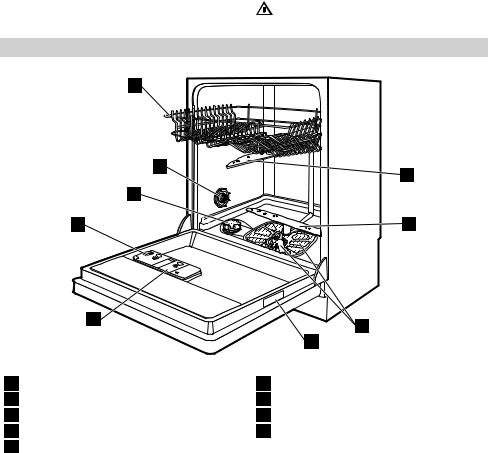
ENGLISH |
5 |
Installation
•Make sure that the appliance is not damaged because of transport. Do not connect a damaged appliance. If necessary, contact the supplier.
•Remove all packaging before first use.
•A qualified and competent person must do the electrical installation.
•A qualified and competent person must do the plumbing installation.
•Do not change the specifications or modify this product. Risk of injury and damage to the appliance.
•Do not use the appliance:
–if the mains cable or water hoses are damaged,
–if the control panel, worktop or plinth area are damaged, that you can get access to
the inner side of the appliance.
If you have any doubts, please contact your After Sales Service. Refer to the list of the After Sales Services at the end of user manual.
•Do not drill into the sides of the appliance to prevent damage to hydraulic and electrical components.
Warning! Carefully obey the instructions for electrical and water connections.
Product description
1
2
9
3
4
|
5 |
|
7 |
|
|
|
|
|
|
|
6 |
1 |
Upper basket |
6 |
Rating plate |
2 |
Water hardness dial |
7 |
Filters |
3 |
Salt container |
8 |
Lower spray arm |
4 |
Detergent dispenser |
9 |
Upper spray arm |
5 |
Rinse aid dispenser |
|
|
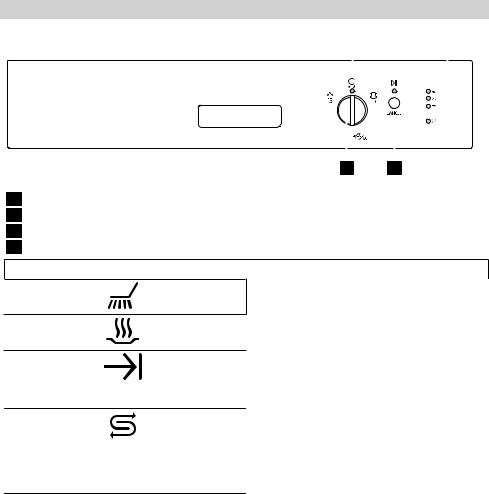
ENGLISH |
6 |
Control panel
4 |
|
|
|
3 |
|||
|
|
|
|
|
|
|
|
|
|
|
|
|
|
|
|
|
|
|
|
|
|
|
|
|
|
|
|
|
|
|
|
|
|
|
|
|
|
|
|
|
|
|
|
|
|
|
|
1 2
1Programme knob
2Start/cancel button
3Indicator lights
4On/off indicator light
Indicator lights
The indicator light comes on when the washing phase or the rinsing phase operates.
The indicator light comes on when the drying phase operates.
The indicator light comes on when the washing programme is completed. Auxiliary functions:
• Level of the water softener.
• An alarm if the appliance has a malfunction.
The indicator light comes on when it is necessary to fill the salt container. Refer to the chap-
1) ter 'Use of dishwasher salt'.
The salt indicator light can stay on for some hours, but it does not have an unwanted effect on the operation of the appliance.
1) The indicator light is off while a washing programme operates.
Programme knob and on/off indicator light
•To set a washing programme, turn the programme knob clockwise or anticlockwise. The programme marker on the programme knob must agree with one of the washing programmes on the control panel.
–The on/off indicator light comes on (position ON).
•To set the appliance to the off position, turn the programme knob until the programme marker agrees with the on/off indicator light.
–The on/off indicator light goes off (position OFF).
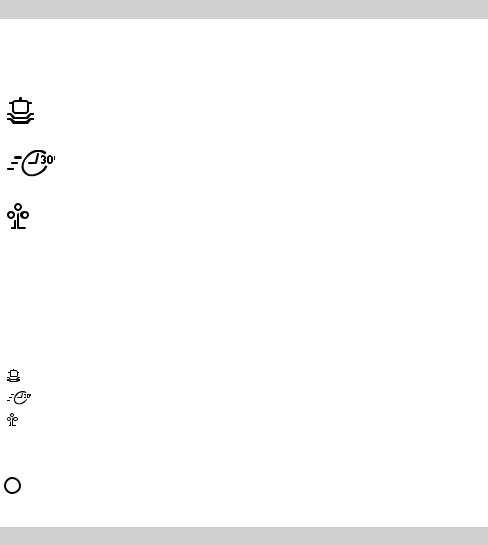
ENGLISH |
7 |
Washing programmes
Washing programmes
Programme |
Degree of |
Type of |
Programme description |
|
soil |
load |
|||
|
|
|||
|
|
Crockery, |
Prewash |
|
|
|
Main wash up to 70°C |
||
|
|
cutlery, |
||
|
Heavy soil |
2 intermediate rinses |
||
Intensive |
pots and |
|||
|
Final rinse |
|||
|
|
pans |
||
|
|
Drying |
||
|
|
|
||
Quick 1) |
Normal or |
Crockery |
Main wash up to 60°C |
|
light soil |
and cutlery |
Final rinse |
||
|
|
|
Prewash |
|
|
Normal |
Crockery |
Main wash up to 50°C |
|
Eco 2) |
1 intermediate rinse |
|||
soil |
and cutlery |
|||
|
|
|
Final rinse |
|
|
|
|
Drying |
1)This is the perfect daily programme to clean a not fully load. Ideal for a family of 4 persons who only want to load breakfast and dinner crockery and cutlery.
2)Test programme for test institutes. This is the economy washing programme. Please refer to separate leaflet supplied, for test data. Available only in 3 languages (English, French, German) just for test institutes purpose.
Consumption values (for full washing cycle)
Programme |
Programme duration |
Energy consumption |
Water consumption |
|
(minutes) |
(kWh) |
(litres) |
|
85-95 |
1,8-2,0 |
22-25 |
|
|
|
|
|
30 |
0,9 |
9 |
|
|
|
|
1) |
130-140 |
1,0-1,2 |
14-16 |
|
|
|
|
|
|
|
|
1)The duration of this washing programme is prefixed (longer) than the others due to a prolonged drying and washing phases.
 The pressure and temperature of the water, the variations of power supply and the quantity of dishes can change these values.
The pressure and temperature of the water, the variations of power supply and the quantity of dishes can change these values.
Use of the appliance
Refer to the following instructions for each step of procedure:
1.Make a check if the water softener level is correct for the water hardness in your area. If necessary set the water softener.
2.Fill the salt container with dishwasher salt.
3.Fill the rinse aid dispenser with rinse aid.
4.Load cutlery and dishes into the dishwasher.
5.Set the correct washing programme for the type of load and soil.
6.Fill the detergent dispenser with the correct quantity of detergent.
7.Start the washing programme.

ENGLISH |
8 |
If you use detergent tablets, refer to the chapter 'Use of detergent'.
Setting the water softener
The water softener removes minerals and salts from the water supply. Minerals and salts can have bad effect on the operation of the appliance.
Water hardness is measured in equivalent scales:
•German degrees (dH°).
•French degrees (°TH).
•mmol/l (millimol per litre - international unit for the hardness of water).
•Clarke.
Adjust the water softener to the water hardness in your area. If necessary, contact your local water authority.
|
Water hardness |
|
Water hardness setting |
||
°dH |
°TH |
mmol/l |
Clarke |
manually |
electronically |
51 - 70 |
91 - 125 |
9,1 - 12,5 |
64 - 88 |
2 |
10 |
43 - 50 |
76 - 90 |
7,6 - 9,0 |
53 - 63 |
2 |
9 |
37 - 42 |
65 - 75 |
6,5 - 7,5 |
46 - 52 |
2 |
8 |
29 - 36 |
51 - 64 |
5,1 - 6,4 |
36 - 45 |
2 |
7 |
23 - 28 |
40 - 50 |
4,0 - 5,0 |
28 - 35 |
2 |
6 |
19 - 22 |
33 - 39 |
3,3 - 3,9 |
23 - 27 |
2 |
5 |
15 - 18 |
26 - 32 |
2,6 - 3,2 |
18 - 22 |
1 |
4 |
11 - 14 |
19 - 25 |
1,9 - 2,5 |
13 - 17 |
1 |
3 |
4 - 10 |
7 - 18 |
0,7 - 1,8 |
5 - 12 |
1 |
2 |
< 4 |
< 7 |
< 0,7 |
< 5 |
11) |
11) |
1) No use of salt required. |
|
|
|
You must set the water softener manually |
1 |
2 |
|
and electronically. |
|||
|
|
Manual adjustment
The appliance is set at the factory at position 2.
Set switch to position 1 or 2.

ENGLISH
Electronic adjustment
The water softener is set at the factory at level 5.
1.Press and hold the start/cancel button. Turn the programme knob clockwise until the programme marker agrees with the first washing programme on the control panel.
2.Release the start/cancel button when the on/off indicator light and the start/cancel indicator light start to flash.
–At the same time, the end indicator light flashes to show the level of the water softener.
Use of dishwasher salt
Caution! Only use dishwashers salt. Types of salt that are not applicable for
dishwashers cause damage to the water softener.
1 2
3 |
4 |
Fill the salt container |
Fill the salt container |
with 1 litre of water |
with 1,5-2,0 kg of |
(only the first opera- |
salt. Use the salt fun- |
tion). |
nel supplied. |
9
Example:
5 flashes, pause, 5 flashes, pause, etc...
=level 5
3.Press the start/cancel button one time to increase the water softener level by one step.
The end indicator light shows the new level.
4.Turn the programme knob to the off position to save the operation.
5 |
6 |
Make sure that there is no grain of salt outer of the salt compartment.
It is normal that water overflows from the salt container when you fill it with salt.
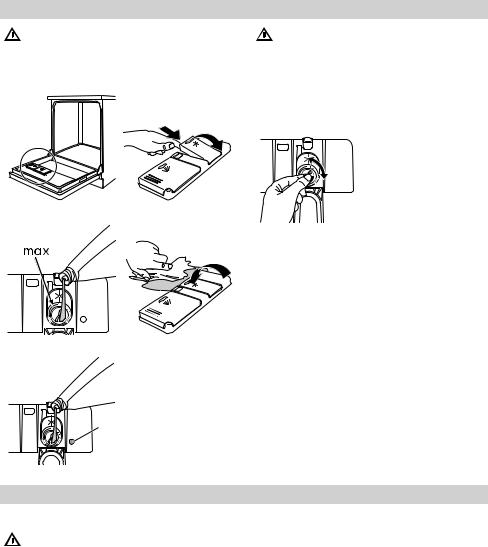
ENGLISH
Use of rinse aid
Caution! Only use branded rinse aid for dishwashers.
Do these steps to fill the rinse aid dispenser:
1 |
2 |
3 |
|
4 |
||
|
|
|
|
|
|
|
|
|
|
|
|
|
|
|
5 |
Fill when the rinse aid |
|
indicator ( A ) be- |
|
comes clear. |
10
Caution! Do not fill the rinse aid dispenser with other products (e.g.
dishwasher cleaning agent, liquid detergent). This can cause damage to the appliance.
Adjusting the dosage of rinse aid
The rinse aid dial is set at the factory at
position 4.
To increase or decrease the dosage refer to 'What to do if...'
A
Loading cutlery and dishes
Helpful hints and tips
Caution! Only use the appliance for household utensils that are applicable for
dishwashers.
Do not use the appliance to clean objects that can absorb water (sponges, household cloths, etc.).
•Before you load cutlery and dishes, do these steps:
– Remove all food remainings and debris.
– Make burnt, remaining food in pans soft.

ENGLISH |
11 |
•While you load cutlery and dishes, do these steps:
–Load hollow items (e.g. cups, glasses and pans) with the opening down.
–Make sure that water does not collect in the container or in a deep base.
–Make sure that cutlery and dishes do not lie inside one another.
–Make sure that cutlery and dishes do not cover other cutlery and dishes.
–Make sure that glasses do not touch other glasses.
–Put small objects in the cutlery basket.
•Plastic items and pans with non-stick coatings can keep water droplets. Plastic items do not dry as well as porcelain and steel items.
•Put light items in the upper basket. Make sure that the items do not move.
Caution! Make sure that the spray arms can move freely before you start a
washing programme.
Warning! Always close the door after you load or unload the appliance. An
open door can be dangerous.
Arrange service dishes and large lids around the edge of the lower basket.
Use the cutlery grid. If the dimensions of the cutlery prevent use of the cutlery grid,
remove it.
Arrange the items to let water touch all surfaces (left). For longer items fold the cup racks up (right).
Put plates in the rear part of the upper basket. Tilt them forward.
Adjustment of the height of the upper basket
If you put large plates in the lower basket, first move the upper basket to a upper position.
Warning! Adjust the height before you load the upper basket.
Maximum height of the dishes in :
•Upper basket.
–Upper position: 20 cm.
–Lower position: 24 cm.
•Lower basket.
–Upper position: 31 cm.
–Lower position: 27 cm.

ENGLISH |
12 |
|
|
Do these steps to move the upper basket to the |
||
A |
A |
upper or lower position: |
||
1. |
Move the front runner stops (A) out. |
|||
|
|
|||
|
|
2. |
Pull the basket out. |
|
|
|
3. |
Put the basket in the upper or lower posi- |
|
|
|
4. |
tion. |
|
|
|
Replace the front runner stops (A) in their |
||
|
|
|
initial position. |
|
|
|
|
Caution! If the basket is in the upper |
|
|
|
|
position, do not put cups on the cup racks. |
|
Use of detergent
Only use detergents (powder, liquid or tablet) that are applicable for dishwash-
ers.
Follow the data on the packaging:
•Dosage recommended by the manufacturer.
•Storage recommendations.
Do not use more than the correct quantity of detergent to save an environment.
1 |
2 |
3
 A
A
Fill the detergent dispenser (A) with detergent.
5
4
 B
B
If you use a washing programme with prewash phase, put more detergent in the prewash detergent compartment
(B).
6
A
Use of detergent tablets
Put the detergent tablet in the detergent dispenser (A).
Detergent tablets contain:
•detergent
•rinse aid
•other cleaning agents.
Do these steps to use detergent tablets:
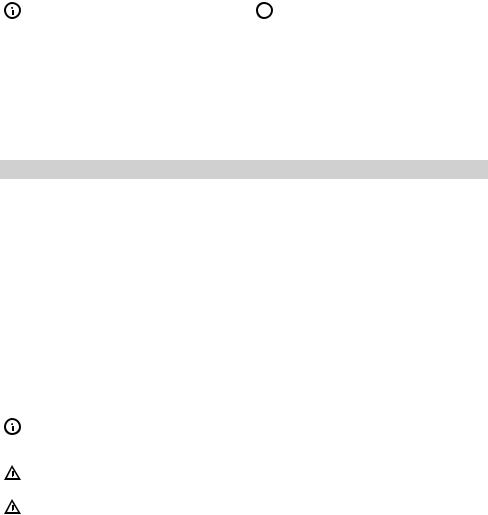
ENGLISH |
13 |
1.Make sure that the detergent tablets are applicable for your water hardness. Refer to the instructions from the manufacturer.
2.Set the lowest levels of water hardness and rinse aid dosage.
It is not necessary to fill the salt container and the rinse aid dispenser.
Do these steps when the drying results are not satisfactory:
1.Fill the rinse aid dispenser with rinse aid.
2.Set the rinse aid dosage to position 2.
Do these steps to use the detergent powder again:
1.Fill the salt container and the rinse aid dispenser.
2.Set the water softener to the highest level.
3.Do a washing programme without dishes.
4.Adjust the water softener. Refer to the chapter 'Setting the water softener'.
5.Adjust the rinse aid dosage.
 Different brands of detergent dissolve in different times. Some detergent tablets do not have the best cleaning results during
Different brands of detergent dissolve in different times. Some detergent tablets do not have the best cleaning results during
short washing programmes. Use long washing programmes when you use detergent tablets to fully remove the detergent.
Setting and starting a washing programme
Do these steps to set and start a washing programme:
1.Close the door.
2.Turn the programme knob to set the washing programme. Refer to the chapter 'Washing programmes'.
–The on/off indicator light comes on.
–The phase indicator light for the washing programme starts to flash.
3.Press the start/cancel button.
–The washing programme starts automatically.
–The start/cancel indicator light comes on.
–When the programme starts, only the phase in progress indicator light stays on.
When the washing programme operates, you cannot change the programme. Can-
cel the washing programme.
Warning! Only interrupt or cancel a washing programme if necessary.
Caution! Open the door carefully. Hot steam can come free.
Cancelling a washing programme
•Press and hold the start/cancel button for approximately 5 seconds.
–The start/cancel indicator light goes off.
–The phase indicator lights starts to flash. The washing programme is cancelled.
At this time you can do these steps: 1. Switch off the appliance.
2. Set a new washing programme.
Fill the detergent dispenser with detergent before you set a new washing programme.
Interrupting a washing programme
Open the door.
•The programme stops. Close the door.
•The programme continues from the point of interruption.
End of the washing programme
Switch off the appliance in these conditions:
•The appliance stops automatically.
•The end indicator light comes on.
For better drying results, keep the door ajar for some minutes before you remove the dishes. Let the dishes cool down before you remove them from the appliance. Hot dishes are easily damaged.
Removing the load
•First remove items from the lower basket, then from the upper basket.
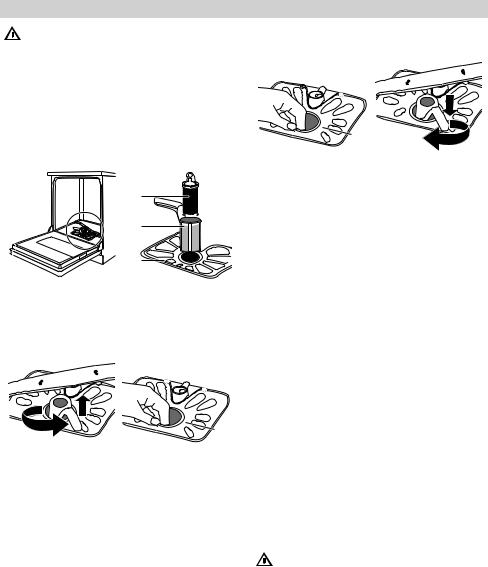
ENGLISH |
14 |
•There can be water on the sides and door of the appliance. Stainless steel becomes cool more quickly than the dishes.
Care and cleaning
Warning! Switch the appliance off before you clean the filters.
Cleaning the filters
Important! Do not use the appliance without the filters. Make sure that the installation of the filters is correct. Incorrect installation will cause unsatisfactory washing results and damage to the appliance.
1 |
2 |
C
B
A
|
Fully clean the filters |
|
A, B and C below run- |
|
ning water. |
3 |
4 |
|
2 |
1 |
A |
|
To remove filters B Remove the flat filter and C, turn the han- A from the bottom of dle approximately the appliance.
1/4 anticlockwise.
5 6
 D
D
|
1 |
A |
2 |
Put the flat filter A in |
Put the filter system in |
the bottom of the ap- |
position. To lock the |
pliance. Install the |
filter system, turn the |
flat filter correctly un- |
handle clockwise un- |
der the two guides D. |
til it locks in position. |
Important! Do not remove the spray arms.
If the holes in the spray arms become clogged, remove remaining parts of soil with a cocktail stick.
Long periods of non-operation
Do these steps when you do not use the appliance for a long period:
1.Disconnect the mains plug from the mains socket.
2.Close the water tap.
3.Keep the door open to prevent unpleasant smells.
4.Keep the inner side of the appliance clean (filters especially).
External cleaning
Clean the external surfaces of the appliance and control panel with a damp soft cloth. Only use neutral detergents. Do not use abrasive products, scouring pads or solvents (acetone, trichloroethylene etc...).
Frost precautions
Caution! Do not install the appliance where the temperature is below 0 °C. The
manufacturer is not responsible for damage because of frost.

ENGLISH |
15 |
If not possible, empty the appliance and close the door. Disconnect the water inlet hose and remove water from the water inlet hose.
What to do if…
The appliance does not start or stops during operation.
If there is a fault, first try to find a solution to the problem yourself. If you cannot find a solution to the problem yourself, contact your dealer or the After Sales Service.
|
Problem |
|
Possible cause |
Solution |
|
• |
Continuous |
flash |
The water tap is blocked or furred |
Clean the water tap. |
|
|
of the |
start/can- |
with limescale. |
|
|
|
cel indicator light. |
|
|
||
|
The water tap is closed. |
Open the water tap. |
|||
• 1 flash of the end |
|
|
|||
|
indicator light. |
The filter in the water inlet hose is |
Clean the filter. |
||
Malfunction: |
|
blocked. |
|
||
The |
dishwasher |
|
|
||
The connection of the water inlet |
Make sure that the connection is |
||||
does not fill with wa- |
hose is not correct. The hose can be |
correct. |
|||
ter. |
|
|
kinked or squashed. |
|
|
|
|
|
|
|
|
• |
Continuous |
flash |
There is a blockage in the sink spi- |
Clean the sink spigot. |
|
|
of the |
start/can- |
got. |
|
|
|
cel indicator light. |
|
|
||
|
The connection of the water drain |
Make sure that the connection is |
|||
• 2 flashes of the |
hose is not correct. The hose can be |
correct. |
|||
|
end |
indicator |
kinked or squashed. |
|
|
|
light. |
|
|
|
|
Malfunction: |
|
|
|
||
The dishwasher will |
|
|
|||
not drain. |
|
|
|
||
• |
Continuous |
flash |
Close the water tap and contact your local After Sales Service. |
||
|
of the |
start/can- |
|
|
|
|
cel indicator light. |
|
|
||
•3 flashes of the end indicator light.
Malfunction:
The anti-flood device operates.
Malfunction: |
The appliance door is not closed. |
Close the door. |
||
The |
programme |
|
|
|
Mains plug is not connected in. |
Put in the mains. |
|||
does not start. |
|
|
||
The fuse has blown out in the |
Replace the fuse. |
|||
|
|
|||
|
|
household fuse box. |
|
|
After the check, switch on the appliance. The programme continues from the point of interruption. If the malfunction shows again, contact your After Sales Service.

ENGLISH |
16 |
When the cleaning results are not satisfactory:
Problem |
Possible cause |
Solution |
|
The dishes are |
The selected washing programme is |
Set different washing programme. |
|
not clean |
not applicable for the type of load |
|
|
|
and soil. |
|
|
|
The baskets are loaded incorrectly so |
Load the baskets correctly. |
|
|
that water cannot reach all surfaces. |
|
|
|
Spray arms do not turn freely because |
Make sure that the cutlery and dishes |
|
|
of incorrect arrangement of the load. |
do not block the spray arms. |
|
|
The filters are dirty or not correctly in- |
Make sure that the filters are clean |
|
|
stalled. |
and installed correctly. |
|
|
The quantity of detergent is too little |
Make sure that the quantity of deter- |
|
|
or missing. |
gent in detergent dispenser is correct. |
|
Limescales |
The salt container is empty. |
Fill the salt container with salt. |
|
particles on the |
|
|
|
The water softener is adjusted on a |
Set the water softener. |
||
dishes |
wrong level. |
|
|
|
|
||
|
The salt container cap is not closed |
Make sure that the salt container is |
|
|
correctly. |
closed correctly. |
|
The dishes are |
No rinse aid has been used. |
Set the rinse aid dosage. |
|
wet and dull |
|
|
|
The rinse aid dispenser is empty. |
Fill the rinse aid dispenser. |
||
|
|||
There are |
Wrong dosage of rinse aid. |
Decrease the rinse aid dosage. |
|
streaks, milky |
|
|
|
spots or a blu- |
|
|
|
ish coating on |
|
|
|
glasses and |
|
|
|
dishes |
|
|
|
Dry water drop |
Wrong dosage of rinse aid. |
Increase rinse aid dosage. |
|
signs on |
|
|
|
The detergent can be the cause. |
Use different type of detergent. |
||
glasses and |
|||
|
|
||
dishes |
|
|
Technical data
Dimensions |
Width (cm) |
59,6 |
|
Height (cm) |
81,8-87,8 |
|
Depth (cm) |
57,5 |
Water supply pressure1) |
Minimum |
0,5 bar (0,05 MPa) |
|
Maximum |
8 bar (0,8 MPa) |
Capacity (place settings) |
12 |
|
Energy class |
A |
|

ENGLISH |
17 |
Washing class |
A |
Drying class |
A |
Noise (dB(A)) |
52 |
Average annual energy con- |
231 |
sumption (kWh) 2) |
|
Average annual water con- |
3520 |
sumption (litres)2) |
|
1)If the pressure in your area is lower or higher, please contact your After Sales Service.
2)The data is based on the washing programme for test institutes assuming 220 cycles per a year.
Information on the electrical connection, voltage and overall power is given on the rating plate on the inner edge of the dishwasher door.
Installation
Caution! Refer to the assembly instructions, in order to proceed with the
installation.
Warning! Make sure that mains plug is disconnected from the mains socket
during installation.
Place the appliance on the floor and install it under a counter (kitchen worktop or sink).
If a repair is necessary, the appliance must be easily accessible for the engineer.
Put the appliance adjacent to a water tap and a drain.
For the venting of the dishwasher only water fill, water drain and power supply cable openings are necessary.
Water connection
This appliance has a special inlet hose for water stop later defined as aqualock.
Water inlet hose
Connected the appliance to a hot (max. 60°) or cold water supply.
If the hot water comes from alternative sources of energy that are more environmentally friendly (e.g. solar or photovoltaic panels and aeolian), use a hot water supply to decrease energy consumption.
Connect the inlet hose to a water tap with an external thread of 3/4".
Caution! Do not use connection hoses from an old appliance.
 Caution! If you connect the appliance to new pipes or pipes that are not used for a long time, we recommend to run the water
Caution! If you connect the appliance to new pipes or pipes that are not used for a long time, we recommend to run the water
for some minutes before you connect the inlet hose.
Aqualock inlet hose
The inlet hose is a high pressure resistant. It can hold pressure at maximum 6 MPa. From external the inlet hose has a sheathing against eventual damages. If the inner hose breaks, the water that is in the hose will became dark. You can see it across the special transparent sheathing. Turn off the water tap immediately and contact the After Sales Service.
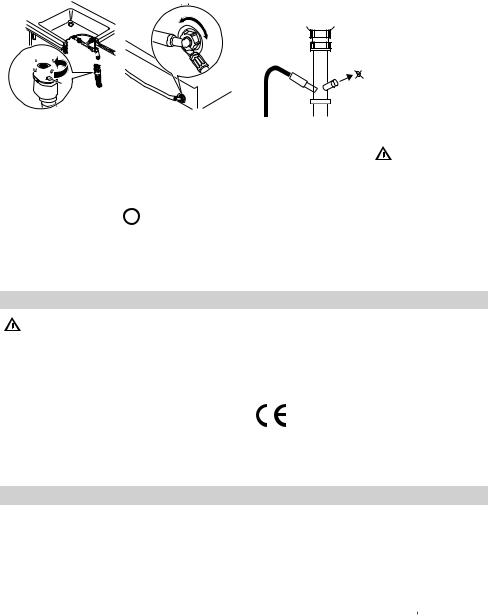
ENGLISH |
18 |
A

B
The aqualock inlet hose is installed with a safety device to prevent accidental loosening. To disconnect the hose:
•Press the lever ( B ).
•Turn the retaining ring ( A ) anticlockwise.
Turn the inlet hose to the left or the right to suit the installation. Tight the locknut correctly to prevent water leaks.
 If you use a inlet hose extension the total reached
If you use a inlet hose extension the total reached
length must be no longer than 4 metres.
Drain hose
|
|
|
|
If you |
connect |
the |
|
|
|
|
water drain hose to a |
||
|
|
|
|
water trap under the |
||
|
|
|
|
|||
|
|
|
|
|||
|
|
|
A |
sink, |
remove |
the |
|
|
|
||||
|
|
|
plastic |
membrane |
||
|
|
|
|
(A). If you do not re- |
||
|
|
|
|
move the membrane, |
||
|
|
|
|
remaining food |
can |
|
|
|
|
|
|||
cause a blockage in the drain hose spigot.
Caution! Make sure that the
water couplings are tight to prevent water leakage.
Electrical connection
Warning! The manufacturer is not responsible if you do not follow these
safety precautions.
Ground the appliance according to safety precautions.
Make sure that the rated voltage and type of power on the rating plate agree with the voltage and the power of the local power supply. Always use a correctly installed shockproof socket.
Do not use multi-way plugs, connectors and extension cables. There is a risk of fire.
Environment concerns
The symbol  on the product or on its packaging indicates that this product may not be treated as household waste. Instead it should be taken to the appropriate collection point for the recycling of electrical and electronic equipment. By ensuring this product is disposed of correctly, you will help prevent potential negative consequences for the environment and human health, which could otherwise be caused by inappropriate waste
on the product or on its packaging indicates that this product may not be treated as household waste. Instead it should be taken to the appropriate collection point for the recycling of electrical and electronic equipment. By ensuring this product is disposed of correctly, you will help prevent potential negative consequences for the environment and human health, which could otherwise be caused by inappropriate waste
Do not replace the mains cable yourself. Contact the After Sales Service.
Make sure that the mains plug is accessible after installation.
Do not pull the mains cable to disconnect the appliance. Always pull the mains plug.
This appliance complies with the E.E.C. Directives.
handling of this product. For more detailed information about recycling of this product, please contact your local council, your household waste disposal service or the shop where you purchased the product.
Packaging materials
The materials with the symbol 
 are recyclable. Dispose the packaging in a suitable collection containers to recycle it.
are recyclable. Dispose the packaging in a suitable collection containers to recycle it.

ENGLISH
Before disposal of appliance
Warning! Do these steps to dispose the appliance:
• Pull the mains plug out of the mains socket.
IKEA GUARANTEE
How long is the IKEA guarantee valid?
This guarantee is valid for five (5) years from the original date of purchase of Your appliance at IKEA, unless the appliance is named LAGAN in which case two (2) years of guarantee apply. The original sales receipt is required as proof of purchase. If service work is carried out under guarantee, this will not extend the guarantee period for the appliance,
Which appliances are not covered by the IKEA five (5) years guarantee?
The range of appliances named LAGAN and all appliances purchased in IKEA before 1st of August 2007
Who will execute the service?
IKEA service provider will provide the service through its own service operations or authorized service partner network.
What does this guarantee cover?
The guarantee covers faults of the appliance, which have been caused by faulty construction or material faults from the date of purchase from IKEA. This guarantee applies to domestic use only. The exceptions are specified under the headline “What is not covered under this guarantee?” Within the guarantee period, the costs to remedy the fault e.g. repairs, parts, labour and travel will be covered, provided that the appliance is accessible for repair without special expenditure. On these conditions the EU guidelines (Nr. 99/44/EG) and the respective local regulations are applicable. Replaced parts become the property of IKEA.
19
•Cut off the mains cable and discard it.
•Discard the door catch. This prevents the children to close themselves inside the appliance. Risk of suffocation.
What will IKEA do to correct the problem?
IKEA appointed service provider will examine the product and decide, at its sole discretion, if it is covered under this guarantee. If considered covered, IKEA service provider or its authorized service partner through its own service operations, will then, at its sole discretion, either repair the defective product or replace it with the same or a comparable product.
What is not covered under this guarantee?
•Normal wear and tear.
•Deliberate or negligent damage, damage caused by failure to observe operating instructions, incorrect installation or by connection to the wrong voltage, damage caused by chemical or electro-chemical reaction, rust, corrosion or water damage including but not limited to damage caused by excessive lime in the water supply, damage caused by abnormal environmental conditions.
•Consumable parts including batteries and lamps.
•Non-functional and decorative parts which do not affect normal use of the appliance, including any scratches and possible color differences.
•Accidental damage caused by foreign objects or substances and cleaning or unblocking of filters, drainage systems or soap drawers.
•Damage to the following parts: ceramic glass, accessories, crockery and cutlery baskets, feed and drainage pipes, seals, lamps and lamp covers, screens, knobs, casings and parts of casings. Unless such damages can be proved to have been caused by production faults.
•Cases where no fault could be found during a technician’s visit.

ENGLISH |
20 |
•Repairs not carried out by our appointed service providers and/or an authorized service contractual partner or where nonoriginal parts have been used.
•Repairs caused by installation which is faulty or not according to specification.
•The use of the appliance in a non-domestic environment i.e. professional use.
•Transportation damages. If a customer transports the product to their home or other address, IKEA is not liable for any damage that may occur during transport. However, if IKEA delivers the product to the customer's delivery address, then damage to the product that occurs during this delivery will be covered by this guarantee.
•Cost for carrying out the initial installation of the IKEA appliance. However, if an IKEA service provider or its authorized service partner repairs or replaces the appliance under the terms of this guarantee, the serv-
ice provider or its authorized service partner will re-install the repaired appliance or install the replacement, if necessary.
This restriction do not apply to fault-free work carried out by a qualified specialist using our original parts in order to adapt the appliance to the technical safety specifications of another EU country.
How country law applies
The IKEA guarantee gives You specific legal rights, which covers or exceed local demands. However these conditions do not limit in any way consumer rights described in the local legislation
Area of validity
For appliances which are purchased in one EU country and taken to another EU country, the services will be provided in the framework of the guarantee conditions normal in the new country. An obligation to carry out services in the framework of the guarantee exists only if the appliance complies and is installed in accordance with:
•the technical specifications of the country in which the guarantee claim is made;
•the Assembly Instructions and User Manual Safety Information;
The dedicated After Sales Service for IKEA appliances:
Please do not hesitate to contact IKEA After Sales Service to:
1.make a service request under this guarantee;
2.ask for clarification on installation of the IKEA appliance in the dedicated IKEA kitchen furniture. The service won’t provide clarifications related to:
–the overall IKEA kitchen installation;
–connections to electricity (if machine comes without plug and cable), to water and to gas since they have to be executed by an authorized service engineer.
3.ask for clarification on user manual contents and specifications of the IKEA appliance.
To ensure that we provide you with the best assistance, please read carefully the Assembly Instructions and/or the User Manual section of this booklet before contacting us.
How to reach us if You need our service
Please refer to the last page of this manual for the full list of IKEA appointed contacts and relative national phone numbers.
Important! In order to provide You with a quicker service, we recommend that You use the specific phone numbers listed at the end of this manual. Always refer to the numbers listed in the booklet of the specific appliance You need an assistance for. Before calling us, assure that You have to hand the IKEA article number (8 digit code) for the appliance of which you need our assistance.
Important! SAVE THE SALES RECEIPT! It is Your proof of purchase and required for the guarantee to apply. Note that the receipt reports also the IKEA article name and number (8 digit code) for each of the appliances you have purchased.
ENGLISH |
21 |
Do You need extra help?
For any additional questions not related to After Sales of your appliances, please contact
our nearest IKEA store call centre. We recommend you read the appliance documentation carefully before contacting us.

DEUTSCH |
22 |
Inhalt
Sicherheitshinweise |
22 |
Auswählen und Starten eines Spülprogramms |
|
Gerätebeschreibung |
24 |
Reinigung und Pflege |
32 |
Bedienblende |
24 |
33 |
|
Spülprogramme |
25 |
Was tun, wenn … |
34 |
Verwendung des Geräts |
26 |
Technische Daten |
36 |
Einstellen des Wasserenthärters |
27 |
Gerät aufstellen |
37 |
Gebrauch von Salz für Geschirrspüler |
28 |
Wasseranschluss |
37 |
Gebrauch von Klarspülmittel |
28 |
Elektrischer Anschluss |
38 |
Laden von Besteck und Geschirr |
29 |
Umwelttipps |
38 |
Gebrauch von Spülmittel |
31 |
IKEA GARANTIE |
39 |
Änderungen vorbehalten
 Sicherheitshinweise
Sicherheitshinweise
 Lesen Sie diese Bedienungsanleitung bitte sorgfältig durch, bevor Sie das Gerät anschließen und benutzen, um Gefahren zu vermeiden und einen korrekten Betrieb des Geräts zu gewährleisten. Bewahren Sie diese Bedienungsanleitung in der Nähe des Geräts auf, auch wenn Sie dieses anderswo aufstellen. Wenn Sie das Gerät verkaufen, geben Sie dem Käufer die Bedienungsanleitung mit. Jeder, der dieses Gerät benutzt, sollte mit der Bedienung und den Sicherheitsmerkmalen vertraut
Lesen Sie diese Bedienungsanleitung bitte sorgfältig durch, bevor Sie das Gerät anschließen und benutzen, um Gefahren zu vermeiden und einen korrekten Betrieb des Geräts zu gewährleisten. Bewahren Sie diese Bedienungsanleitung in der Nähe des Geräts auf, auch wenn Sie dieses anderswo aufstellen. Wenn Sie das Gerät verkaufen, geben Sie dem Käufer die Bedienungsanleitung mit. Jeder, der dieses Gerät benutzt, sollte mit der Bedienung und den Sicherheitsmerkmalen vertraut
sein.
Bestimmungsgemäßer Gebrauch
•Dieses Gerät ist ausschließlich zur Verwendung im Haushalt bestimmt.
•Spülen Sie in diesem Gerät ausschließlich spülmaschinengeeignete Haushaltsutensilien.
•Geben Sie keine Lösungsmittel in das Gerät. Andernfalls besteht Explosionsgefahr.
•Ordnen Sie Messer und andere spitze Gegenstände mit der Spitze nach unten in den Besteckkorb ein. Oder legen Sie sie horizontal in den Oberkorb.
•Verwenden Sie ausschließlich Markenreinigungsprodukte für Geschirrspüler (Spülmittel, Salz, Klarspüler).
•Wenn Sie die Tür öffnen, während das Gerät in Betrieb ist, kann heißer Dampf austreten. In diesem Fall besteht die Gefahr von Hautverbrennungen.
•Nehmen Sie vor dem Ende des Spülprogramms nichts aus dem Geschirrspüler.
•Wenn das Spülprogramm beendet ist, ziehen Sie den Netzstecker aus der Netzsteckdose und schließen Sie den Wasserhahn.
•Das Gerät darf nur von einem Servicetechniker einer autorisierten Kundendienststelle repariert werden. Dabei dürfen ausschließlich Originalersatzteile verwendet werden.
•Versuchen Sie nicht, selbst Reparaturen auszuführen. Andernfalls besteht Unfallgefahr und das Gerät könnte beschädigt werden. Wenden Sie sich stets an Ihren lokalen Kundendienst.
Allgemeine Sicherheitshinweise
•Das Gerät darf von Erwachsenen oder Kindern mit eingeschränkten physischen, sensorischen oder geistigen Fähigkeiten oder einem Mangel an Wissen und Erfahrung nicht benutzt werden. Solche Personen müssen von einer Person beaufsichtigt oder bei der Bedienung des Geräts angeleitet werden, die für ihre Sicherheit verantwortlich ist.
•Beachten Sie die Sicherheitsanweisungen des Reinigungsmittelherstellers, um Verätzungen an Augen, Mund oder Kehlkopf zu vermeiden.
•Trinken Sie kein Wasser aus dem Geschirrspüler. Es können Spülmittelrückstände darin zurückbleiben.
•Wenn Sie das Gerät nicht benutzen, halten Sie die Tür geschlossen, damit es nicht zu Unfällen kommt, weil jemand darüber stolpert.

DEUTSCH |
23 |
•Setzen oder stellen Sie sich nie auf die offene Tür.
Kindersicherheit
•Nur Erwachsene dürfen dieses Gerät bedienen. Kinder müssen beaufsichtigt werden, so dass sie nicht mit dem Gerät spielen können.
•Halten Sie das Verpackungsmaterial von Kindern fern. Andernfalls besteht Erstickungsgefahr.
•Bewahren Sie alle Reinigungsmittel an einem sicheren Ort auf. Achten Sie darauf, dass Reinigungsmittel nicht in die Hände von Kindern gelangen.
•Halten Sie Kinder vom geöffneten Geschirrspüler fern.
Aufstellung
•Vergewissern Sie sich, dass das Gerät beim Transport nicht beschädigt wurde. Schließen Sie ein beschädigtes Gerät nicht an. Wenden Sie sich bei Bedarf an den Hersteller.
•Entfernen Sie vor dem ersten Gebrauch alle Verpackungsmaterialien.
•Der elektrische Anschluss muss von einer qualifizierten Fachkraft vorgenommen werden.
•Die Wasseranschlüsse müssen von einer qualifizierten Fachkraft vorgenommen werden.
•Nehmen Sie weder technische noch anderweitige Modifikationen am Gerät vor. Andernfalls besteht Unfallgefahr und das Gerät könnte beschädigt werden.
•Benutzen Sie das Gerät nicht:
–wenn das Netzkabel oder die Wasserschläuche beschädigt sind,
–wenn die Bedienblende, die Abdeckung oben oder der Sockel beschädigt sind, so dass das Innere des Geräts freiliegt.
Bei weiteren Fragen wenden Sie sich bitte an unseren Kundenservice. Eine Liste der Kundendienststellen finden Sie am Ende des Benutzerhandbuchs.
•Bohren Sie keine Löcher ins Gehäuse des Geräts. Andernfalls könnten hydraulische oder elektrische Bauteile beschädigt werden.
Warnung! Beachten Sie genau sämtliche Anweisungen zu den elektrischen und
den Wasseranschlüssen.
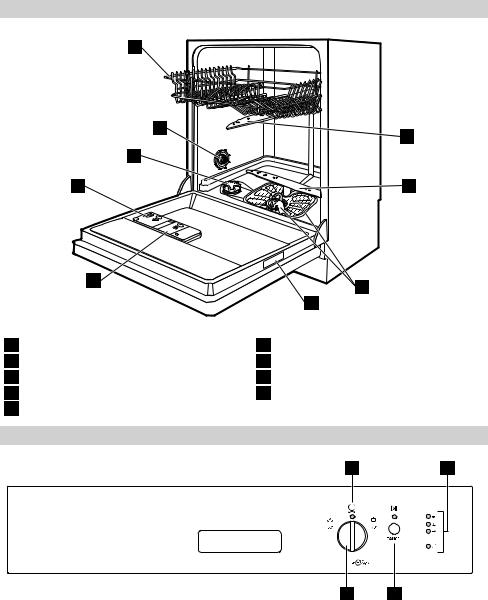
DEUTSCH |
24 |
Gerätebeschreibung
1
2
9
3
4
|
5 |
|
7 |
|
|
|
|
|
|
|
|
|
6 |
|
1 |
Oberkorb |
6 |
Typenschild |
|
2 |
Anzeige der Wasserhärtestufe |
7 |
Filter |
|
3 |
Salzbehälter |
8 |
Unterer Sprüharm |
|
4 |
Behälter für Reinigungsmittel |
9 |
Oberer Sprüharm |
|
5 |
Dosiergerät für Klarspüler |
|
|
|
Bedienblende |
|
|
|
|
|
|
|
4 |
3 |
12
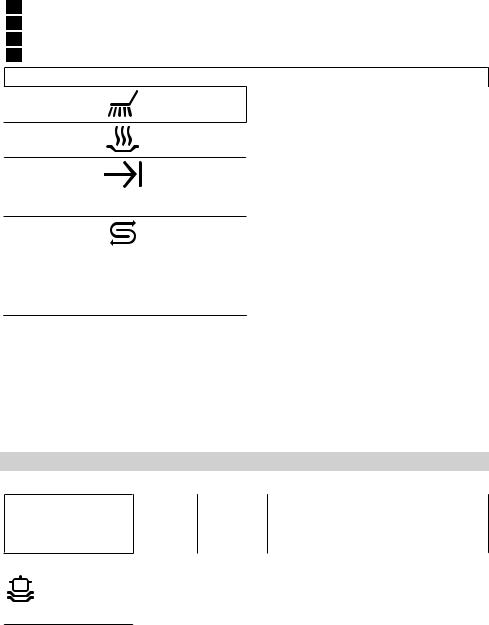
DEUTSCH |
25 |
1Programmwähler
2Start-/Abbruch-Taste
3Kontrolllampen
4Ein/Aus-Betriebsanzeige
Kontrolllampen
Die Kontrolllampe leuchtet während der Reinigungsphase oder der Klarspülphase.
Die Kontrolllampe leuchtet während der Trockenphase.
Diese Kontrolllampe leuchtet auf, wenn das Spülprogramm zu Ende ist. Zusatzfunktionen:
• Einstellung des Wasserenthärters.
• Alarm bei einer Störung des Geräts.
Die Kontrolllampe leuchtet auf, wenn der Salzbehälter aufgefüllt werden muss. Siehe Kapitel
1) "Verwendung von Geschirrspülsalz".
Die Salzkontrolllampe kann nach dem Nachfüllen von Salz noch einige Stunden leuchten. Dies hat jedoch keine unerwünschte Auswirkung auf den Gerätebetrieb.
1) Die Kontrolllampe ist aus, während ein Spülprogramm läuft.
Programmwähler und Ein/Aus-
Betriebsanzeige
•Drehen Sie den Programmwähler zum Einstellen eines Spülprogramms im Uhrzeigersinn oder gegen den Uhrzeigersinn. Die Referenzmarkierung am Programmwähler muss auf eins der Spülprogramme auf der Bedienblende zeigen.
–Die Ein/Aus-Betriebsanzeige leuchtet auf (Position EIN).
•Um das Gerät auszuschalten, drehen Sie den Programmwähler, bis die Referenzmarkierung auf die Ein/Aus-Betriebsanzeige zeigt.
–Die Ein/Aus-Betriebsanzeige erlischt (Position AUS).
Spülprogramme
Spülprogramme
Grad der
Programm Ver- Spülgut Programmbeschreibung schmut-
zung
|
|
Geschirr, |
Vorspülgang |
|
|
|
Hauptspülgang bis zu 70 °C |
||
|
Stark ver- |
Besteck, |
||
|
2 Zwischenspülgänge |
|||
Intensiv |
schmutzt |
Töpfe, |
||
Klarspülgang |
||||
|
|
Pfannen |
||
|
|
trocknen |
||
|
|
|
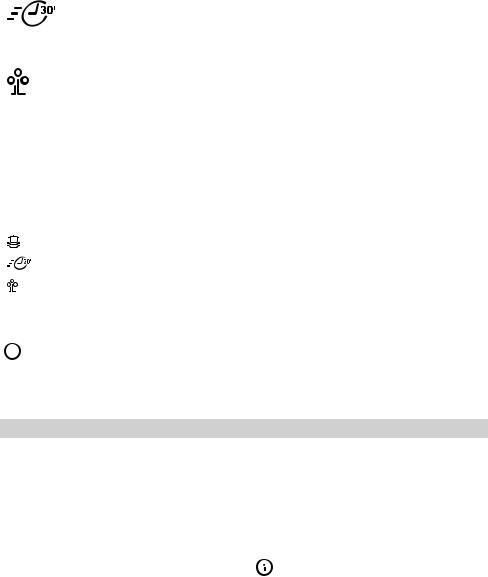
DEUTSCH |
26 |
|
Grad der |
|
|
|
Programm |
Ver- |
Spülgut |
Programmbeschreibung |
|
schmut- |
||||
|
|
|
||
|
zung |
|
|
|
|
Normal/ |
Geschirr |
Hauptspülgang bis zu 60 °C |
|
Schnellspül- |
leicht ver- |
Klarspülgang |
||
und Besteck |
||||
gang 1) |
schmutzt |
|
|
|
|
Normal |
|
Vorspülgang |
|
|
Geschirr |
Hauptspülgang bis zu 50 °C |
||
Öko 2) |
ver- |
1 Zwischenspülgang |
||
und Besteck |
||||
|
schmutzt |
|
Klarspülgang |
|
|
|
|
trocknen |
1)Dies ist das ideale tägliche Spülprogramm für eine 4-köpfige Familie. die lediglich das Frühstücksund Abendessensgeschirr samt Besteck spülen möchte.
2)Testprogramm für Testinstitute. Dies ist das Öko-Spülprogramm. Die Testdaten finden Sie auf dem mitgelieferten separaten Infoblatt. Nur in drei Sprachen erhältlich (Englisch, Französisch, Deutsch) nur für Testzwecke an Prüfinstituten.
Verbrauchswerte (für ungekürzte Spülgänge)
Programm |
Programmdauer (in |
Energieverbrauch |
Wasserverbrauch (in |
|
Minuten) |
(kWh) |
Liter) |
|
85-95 |
1,8-2,0 |
22-25 |
|
|
|
|
|
30 |
0,9 |
9 |
|
|
|
|
1) |
130-140 |
1,0-1,2 |
14-16 |
|
|
|
|
|
|
|
|
1)Die Dauer dieses Spülprogramms ist fest vorgegeben (länger) und aufgrund der verlängerten Spülund Trockenphasen länger als andere Programme.
 Die Verbrauchswerte sind Richtwerte, die je nach dem Druck und der Temperatur des Wassers, den Schwankungen in der Strom-
Die Verbrauchswerte sind Richtwerte, die je nach dem Druck und der Temperatur des Wassers, den Schwankungen in der Strom-
versorgung und der Geschirrmenge variieren können.
Verwendung des Geräts
Bitte halten Sie sich für die folgenden Schritte genau an die Anweisung:
1.Überprüfen Sie, ob der Wasserenthärter (Weichwasserbereiter) korrekt auf den Härtegrad des Wassers in Ihrer Region eingestellt ist. Stellen Sie den Wasserenthärter bei Bedarf auf die richtige Stufe ein.
2.Füllen Sie den Salzbehälter mit Geschirrspülsalz.
3.Füllen Sie den Klarspüldosierer mit Klarspüler.
4.Ordnen Sie Geschirr und Besteck in den Geschirrspüler ein.
5.Stellen Sie je nach Spülgut und Verschmutzungsgrad das passende Spülprogramm ein.
6.Füllen Sie den Spülmittelbehälter mit der passenden Menge an Spülmittel.
7.Starten Sie das Spülprogramm.
Wenn Sie Reinigertabletten verwenden, siehe das Kapitel "Gebrauch von Spül-
mitteln".
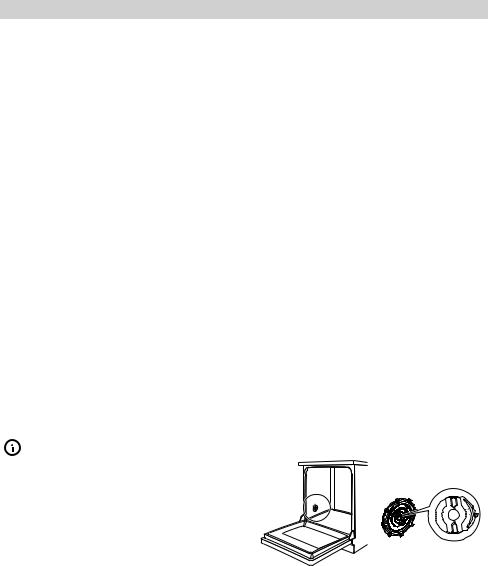
DEUTSCH |
27 |
Einstellen des Wasserenthärters
Der Wasserenthärter entfernt Mineralien und Salze aus dem Spülwasser. Andernfalls könnten sich die Mineralien und Salze nachteilig auf die Funktion des Geräts auswirken.
Die Wasserhärte wird in unterschiedlichen, aber gleichwertigen Einheiten gemessen:
•Deutsche Wasserhärtegrade (dH°).
•Französische Wasserhärtegrade (°TH).
•mmol/l (Millimol pro Liter - internationale Einheit für Wasserhärtegrade).
•Clarke-Werte.
Stellen Sie den Wasserenthärter auf den Wasserhärtegrad in Ihrer Region ein. Bei Bedarf erfahren Sie den Härtegrad bei Ihrem Wasserversorger.
|
Wasserhärte |
|
Einstellung des Wasserenthärters |
||
°dH |
°TH |
mmol/l |
Clarke- |
Manuell |
Elektronisch |
|
|
|
Werte |
|
|
51 - 70 |
91 - 125 |
9,1 - 12,5 |
64 - 88 |
2 |
10 |
43 - 50 |
76 - 90 |
7,6 - 9,0 |
53 - 63 |
2 |
9 |
37 - 42 |
65 - 75 |
6,5 - 7,5 |
46 - 52 |
2 |
8 |
29 - 36 |
51 - 64 |
5,1 - 6,4 |
36 - 45 |
2 |
7 |
23 - 28 |
40 - 50 |
4,0 - 5,0 |
28 - 35 |
2 |
6 |
19 - 22 |
33 - 39 |
3,3 - 3,9 |
23 - 27 |
2 |
5 |
15 - 18 |
26 - 32 |
2,6 - 3,2 |
18 - 22 |
1 |
4 |
11 - 14 |
19 - 25 |
1,9 - 2,5 |
13 - 17 |
1 |
3 |
4 - 10 |
7 - 18 |
0,7 - 1,8 |
5 - 12 |
1 |
2 |
< 4 |
< 7 |
< 0,7 |
< 5 |
1 1) |
1 1) |
1) Kein Salz erforderlich.
Sie müssen den Wasserenthärter manuell und elektronisch einstellen.
Manuelle Einstellung
Werkseitig ist das Gerät auf Stufe 2 eingestellt.
1 |
2 |
Stellen Sie den Schalter auf Stufe 1 oder 2.
Elektronische Einstellung
Werkseitig ist der Wasserenthärter auf Stufe 5 eingestellt.
